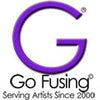
How to use Ferro Goldrush Pens on Glass
HOW TO USE GOLD TO GLASS
Using a Ferro Goldrush pen.
This is a simple process but we recommend you read through the following information to insure successful firing of the gold to your glass.
APPLICATION: The Ferro Goldrush pen contains a liquid gold that can be applied to the glass and then fired to around 1200F (650C) up to 1,325 degrees. After firing to your glass or ceramic it will produce brilliant gold lines. Use the Ferro Goldrush pen for making permanent decorations, writing or signing your glass artwork.
Just like a regular ink pen you first press down on the tip to start the ink flowing. When you first use your pen, shake it and then press several times to make sure you have a flow of gold. After the initial use, you will only have to press the tip one or two times. Then proceed to write or draw on your "Clean" glass.
Clean: It is important to make sure the glass surface is free of oil or fingerprints from your hands. After cleaning your glass handle it by the edges.
As you write or draw the color will look a bit pale and appear brown with a slight gold tint. It will not display as a bright gold color. It will not necessarily apply as a uniform thickness. It is difficult to apply more than one coat at a time so it is best to allow the gold ink to dry and then fire.
ENCASEMENT: The Ferro Goldrush pen can be fire on top of or between layers to 1050F - 1150F (bonds at 1112 degrees F) up to 1,328 degrees.
Note: The Ferro Goldrush pen ink will usually survives a full fuse firing.
Tips to working with any Liquid Gold when firing to Glass or Ceramics:
1. Liquid Gold should be applied sparingly due to the expense so it should be used for decorative, writing or a distinctive touch instead of a full coverage application.
2. Create test samples before using different thickness of application and write on the fused glass to identify each level of application.
3. Brightness of the gold versus a matte finish is controlled by how it is applied. The thinner layers of gold will be brighter when fired, while thicker layers will become more matte in appearance.
4. Manufacturers recommend firing your glass or ceramics to the 1150 to 1325F (620 to 675C) range. If you fire too high, the gold can burn off or reduce it's brilliance. (Ceramics versus glass is an exception because they can have a higher firing rang).
5. Gold always adheres best with a slow firing and a soak (just like the low fire glass decals). By providing time for the gold to adhere firmly to the glass you will produce a great finish piece. Firing too quickly can result in unexpected results like pitting, faint or inconsistent application, etc.
6. ALWAYS vent your kiln when firing gold. The fresh air in to the kiln up to around 1100F (593C) up to 1325 degrees allows the solvents in the liquid gold to burn off and not allow it to contaminate other items in the kiln. It is not recommended to mix gold items with others non gold pieces in the same firing.
Tips:
- The first time you must prime the pen by removing the cap and gently tap the tip of the pen on a hard surface. (This could take several attempts before the felt tip is loaded with gold and it will appear a brownish tone).
- Be careful not to overload the felt tip or when you use the pen, too much gold will flow onto the piece.
- When using the gold pen, if it appears to be getting too thin, prime the felt tip again "only" once or twice and cointue to draw.
- The gold is dark when applying so it is very difficult to see on dark glass. Hold your piece up to the light and from a side angle you can see what you have drawn. Try not to draw over the same area twice. It is better to fire your glass and then draw over any area that is not as expected and re-fire.
- Fired between 1328 & 1157 degrees F.
- Choosing a selection results in a full page refresh.
Newsletter
Quick links
Our mission
Promote the Future of Custom Art Glass by providing inspiration thru sharing creativity and knowledge.
Contact Us
Follow us
!
